Pets
Explore Freshwater Invertebrates Diversity
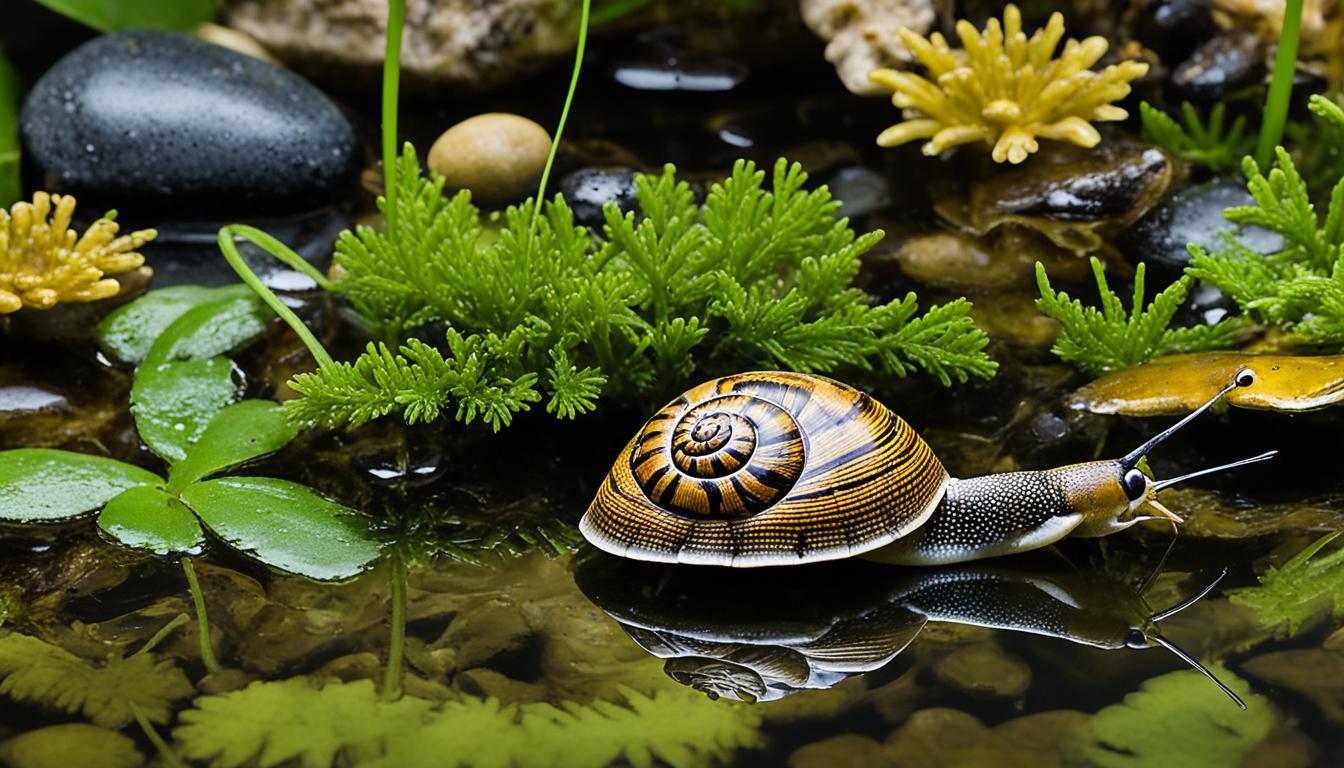
Did you know that freshwater habitats, covering just 1% of the Earth’s surface, house a staggering 10% of all described flora and fauna? These aquatic ecosystems are teeming with life, including a wide variety of fascinating freshwater invertebrates. From snails to prawns and aquatic insects, these invertebrates play a vital role in maintaining the health and biodiversity of freshwater ecosystems.
Key Takeaways:
- Freshwater habitats, despite their small size, harbor 10% of all known species.
- Invertebrates such as snails, prawns, and aquatic insects are crucial for ecosystem health.
- Human activities have had a significant impact on the diversity of freshwater invertebrates.
- Monitoring freshwater invertebrates can help assess water quality and ecosystem functioning.
- Conservation efforts and public awareness are essential for protecting these valuable organisms.
The Importance of Freshwater Invertebrates in Aquatic Ecosystems
Freshwater invertebrates play a vital role in the functioning and health of aquatic ecosystems. These organisms contribute to essential ecosystem processes that are crucial for maintaining a balanced and sustainable environment. With their diverse adaptations and ecological roles, freshwater invertebrates are integral to the biodiversity and overall functioning of freshwater ecosystems.
Organic Matter Decomposition: Freshwater invertebrates are key contributors to the decomposition of organic matter in aquatic ecosystems. They feed on detritus and dead plant and animal material, breaking them down into smaller particles and facilitating the recycling of nutrients. Through their feeding activities, these invertebrates help release nutrients and maintain nutrient cycling in the ecosystem, supporting the growth of other organisms.
Water Filtration: Many freshwater invertebrates, such as filter-feeding mollusks and crustaceans, actively filter and consume suspended particles, algae, and organic matter from the water column. This process not only helps to clarify the water but also plays a crucial role in maintaining water quality. By removing excess nutrients, sediments, and pollutants, these invertebrates contribute to the overall purification of the aquatic environment.
Nutrient Cycling: Freshwater invertebrates are important players in the cycling of nutrients between aquatic and terrestrial ecosystems. As invertebrates consume organic matter from the water, they convert it into biomass. This biomass can then be consumed by predators, including fish and birds, and transferred to the terrestrial ecosystem through their droppings or carcasses. The nutrients released by freshwater invertebrates contribute to the fertility of surrounding soils and support the growth of terrestrial plants.
Energy Flow: Freshwater invertebrates serve as a vital energy source for higher trophic levels in aquatic ecosystems. They are prey for various organisms, including fish, amphibians, and birds, forming an essential part of the food web. The abundance and availability of freshwater invertebrates directly impact the population dynamics and reproductive success of these higher trophic levels.
Ecosystem Indicators: The presence and abundance of freshwater invertebrates can provide valuable insights into the overall health and well-being of aquatic ecosystems. As sensitive organisms, they are greatly affected by changes in water quality, habitat degradation, and pollution. Monitoring populations of freshwater invertebrates can serve as an indicator of ecosystem health and help identify potential threats to biodiversity and ecosystem functioning.
“Freshwater invertebrates contribute to essential ecosystem processes such as organic matter decomposition, water filtration, and nutrient cycling.”
| Freshwater Invertebrates | Ecosystem Contribution |
|---|---|
| Filter-feeding mollusks and crustaceans | Water filtration, nutrient recycling |
| Detritivorous invertebrates | Organic matter decomposition, nutrient cycling |
| Prey for higher trophic levels | Energy flow, supporting food webs |
| Indicator species | Ecosystem health assessment |
In conclusion, freshwater invertebrates play a vital role in maintaining the balance and health of aquatic ecosystems. Their contributions to organic matter decomposition, water filtration, nutrient cycling, energy flow, and ecosystem health assessment highlight the significance of these organisms. To ensure the conservation and preservation of freshwater invertebrates, it is essential to recognize their importance and take proactive measures to protect their habitats and the overall biodiversity of aquatic ecosystems.
Threats to Freshwater Invertebrates
Freshwater invertebrates, such as snails, prawns, and aquatic insects, face numerous threats that jeopardize their survival and the health of aquatic ecosystems. It is crucial to understand these threats in order to take necessary measures to protect these valuable organisms.
Water Pollution
One of the major threats to freshwater invertebrates is water pollution. Agricultural and urban activities contribute to the release of pollutants into freshwater systems, including harmful chemicals, pesticides, and fertilizers. Untreated sewage and wastewater also add to the pollution burden. These pollutants can have detrimental effects on the invertebrate populations, leading to declines in their numbers and compromising their reproductive abilities.
Habitat Destruction
The destruction of freshwater habitats poses another significant threat to invertebrates. Dam construction, channelization, and excessive sedimentation alter the natural flow of water, disrupt the ecosystems, and degrade the habitats where these organisms reside. Invasive species also contribute to habitat destruction by outcompeting native invertebrates for resources, further reducing their numbers and displacing them from their natural habitats.
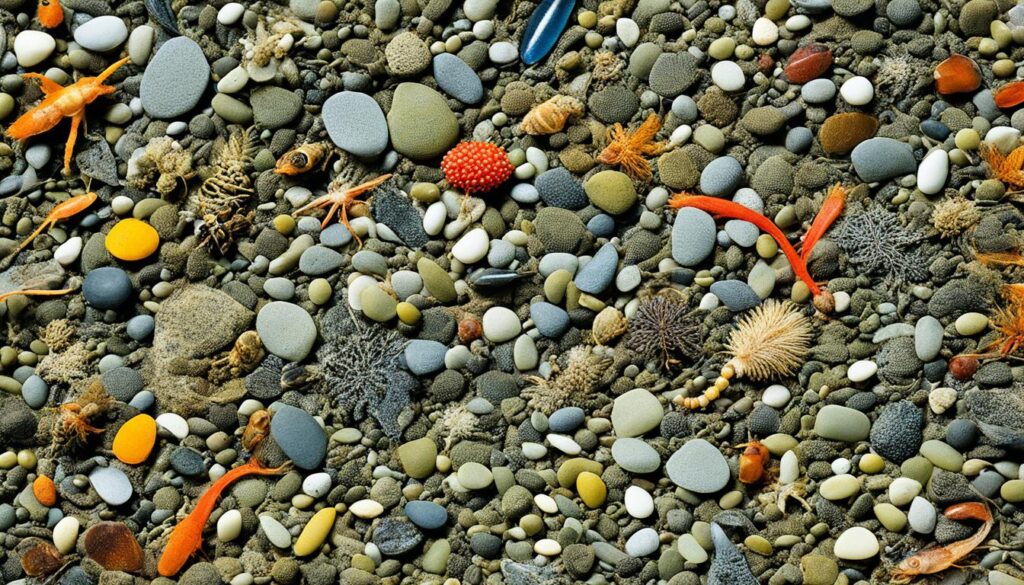
“Water pollution and habitat destruction have serious implications for freshwater invertebrates. These organisms are critical components of the ecosystem, playing key roles in nutrient cycling, decomposition, and overall ecosystem functioning. The loss of freshwater invertebrates can lead to imbalances in the ecosystem, affecting the entire food web and compromising water quality.”
Population Declines and Biodiversity Loss
As a result of the aforementioned threats, freshwater invertebrates experience declines in population size and loss of biodiversity. When these organisms decline, it disrupts the balance of the entire ecosystem. The loss of certain species can have cascading effects on other organisms, leading to a decline in overall biodiversity and the disruption of important ecosystem processes.
It is paramount to address these threats and implement conservation measures to safeguard freshwater invertebrates and maintain the health of aquatic ecosystems. By reducing water pollution, protecting and restoring habitats, and managing invasive species, we can ensure the long-term survival of these valuable organisms and preserve the delicate balance of our freshwater ecosystems.
Monitoring Freshwater Invertebrates
Monitoring freshwater invertebrates is crucial for assessing the health of aquatic ecosystems and ensuring water quality and stream health. Invertebrates, such as snails, prawns, and aquatic insects, serve as valuable indicators of the overall ecological condition.
Scientists collect data on the presence, abundance, and diversity of freshwater invertebrates to gain insights into the impacts of development and pollution on these delicate ecosystems. By studying different species’ tolerance levels to pollution, researchers can evaluate the condition of streams and rivers and identify areas that may require intervention and conservation efforts.
Through monitoring initiatives, scientists can track changes in invertebrate populations and identify potential threats to water quality. This data helps policymakers and conservationists make informed decisions to protect and restore these valuable organisms and their habitats.
Benefits of Freshwater Invertebrate Monitoring:
- Assesses water quality and ecosystem health
- Identifies impacts of development and pollution
- Guides conservation and restoration efforts
- Provides early detection of ecological changes
“Monitoring freshwater invertebrates allows us to understand the ecological condition of our streams and rivers. By assessing their abundances and diversity, we can identify potential threats and take necessary measures to protect these vital organisms and ensure the health of our freshwater ecosystems.” – Dr. Sarah Roberts, Aquatic Ecologist
As part of monitoring efforts, scientists utilize various field sampling techniques, including kick-netting, electrofishing, and water quality testing. This comprehensive approach enables researchers to gather accurate and reliable data on invertebrate communities and their responses to environmental changes.
Sample Monitoring Data: Freshwater Invertebrate Diversity and Abundance
| Sample Site | Species Richness | Abundance | Tolerance to Pollution |
|---|---|---|---|
| Site 1 | 18 | 145 | Low |
| Site 2 | 12 | 90 | Medium |
| Site 3 | 8 | 50 | High |
| Site 4 | 22 | 170 | Low |
Table: Freshwater Invertebrate Diversity and Abundance in Sample Sites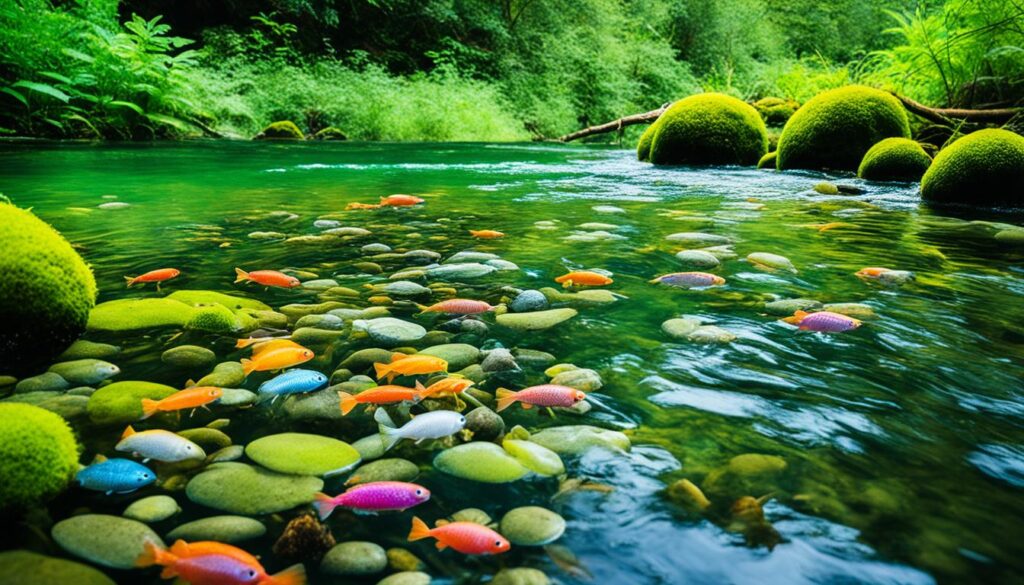
Through ongoing monitoring efforts, scientists can gain a better understanding of the status and trends of freshwater invertebrates. This knowledge is vital for effectively managing and conserving freshwater ecosystems, protecting water quality, and ensuring the long-term health of these unique and diverse habitats.
European Study on Temporal Trends in Freshwater Invertebrates
A recent European study delved into the fascinating world of freshwater invertebrates, analyzing over 1,800 time series of invertebrate communities across 22 countries. Spanning from 1968 to 2020, this comprehensive study provides valuable insights into the temporal trends of freshwater biodiversity.
The findings of the study revealed intriguing patterns in the richness and abundance of freshwater invertebrates. Over the years, there has been a notable increase in taxon richness, functional richness, and overall abundance. This suggests a positive trend in freshwater biodiversity, indicating that these ecosystems are home to a diverse array of invertebrate species.
However, the study also uncovered some concerning aspects. While the overall trend shows an increase in freshwater invertebrate populations, the rate of growth has slowed down in recent years. This plateau in biodiversity gains raises concerns about the long-term survival and conservation of these vital organisms.
Furthermore, the study highlighted specific areas that are particularly vulnerable to biodiversity loss. Freshwater communities downstream of dams, urban areas, and cropland showed limited recovery, indicating the ongoing impact of human activities on these ecosystems. Additionally, sites experiencing faster rates of warming exhibited fewer gains in biodiversity, emphasizing the need to address the effects of climate change on freshwater invertebrates.
The Need for Additional Mitigation Efforts
This European study serves as a powerful reminder of the importance of ongoing conservation efforts to combat the biodiversity loss faced by freshwater invertebrates. It underscores the need for additional mitigation measures to reverse the decline and revive freshwater biodiversity.
By implementing targeted conservation strategies, such as habitat restoration projects and pollution control measures, we can create a more favorable environment for freshwater invertebrates to thrive. Protecting pristine habitats, reducing pollution levels, and addressing the impacts of climate change are essential steps in safeguarding the future of these vital organisms and the ecosystems they inhabit.
The European study on temporal trends in freshwater invertebrates serves as a call to action, urging scientists, policymakers, and the public to come together and work towards the preservation of freshwater biodiversity. By understanding the challenges and opportunities presented by these findings, we can pave the way for a sustainable future, where freshwater invertebrates continue to play their critical roles in maintaining the health and balance of aquatic ecosystems.

The Role of Freshwater Invertebrates in Water Quality Assessment
Freshwater invertebrates play a crucial role in assessing and monitoring water quality in streams and rivers. These diverse organisms, such as insects, worms, and mollusks, can serve as indicators of the overall health of an aquatic ecosystem. By studying the presence and abundance of freshwater invertebrates, scientists can gain valuable insights into the impact of pollution and the state of stream health.
Freshwater Invertebrates as Bioindicators
One of the key reasons why freshwater invertebrates are valuable in water quality assessment is their varying tolerance levels to pollution. Different species have different sensitivities, with some being highly sensitive and only thriving in pristine conditions, while others are more tolerant and can survive in polluted environments. By observing which species are present and which are absent, researchers can assess the extent of pollution in a water body.
In general, a diverse community of freshwater invertebrates indicates good water quality and a healthy stream ecosystem. This is because various species occupy different ecological niches, performing different ecological functions within the ecosystem. Their presence signifies a balanced and well-functioning ecosystem.
Conversely, a decline in freshwater invertebrate diversity and abundance can suggest poor water quality and ecosystem degradation. Pollution, such as excessive nutrient runoff or chemical contamination, can negatively impact invertebrate populations, leading to a decrease in their numbers.
The Importance of Monitoring Freshwater Invertebrates
Regular monitoring of freshwater invertebrates is crucial for determining the effectiveness of pollution control measures and identifying areas that require further attention. Assessing the diversity and abundance of these organisms can provide insights into the current state of water quality, the impacts of pollution, and the overall health of a stream or river ecosystem.
Monitoring efforts typically involve collecting samples of freshwater invertebrates at various locations and analyzing the data. Scientists identify the species present, quantify their abundance, and assess their pollution tolerance. By comparing this information over time, they can track changes in the water quality and detect any trends or patterns.
The Role of Freshwater Invertebrates in Stream Health
Stream health is a vital component of overall ecosystem health. By monitoring the populations of freshwater invertebrates, scientists can gain insights into the condition of a stream and its ability to support diverse aquatic life. Variations in the composition and abundance of invertebrate communities can indicate specific issues, such as pollution, habitat degradation, or changes in water flow.
For example, if pollution levels increase in a stream, sensitive invertebrate species may decline or disappear, leaving behind more pollution-tolerant species. Additionally, changes in the flow or temperature of a stream can affect the distribution and abundance of invertebrates, further impacting stream health. By studying these dynamics, researchers can identify potential threats and guide conservation efforts to restore and protect stream ecosystems.
Examples of Freshwater Invertebrates and Their Pollution Tolerance
| Freshwater Invertebrate | Pollution Tolerance |
|---|---|
| Stonefly nymphs | Highly sensitive to pollution |
| Mayfly nymphs | Highly sensitive to pollution |
| Caddisfly larvae | Moderately sensitive to pollution |
| Dragonfly nymphs | Less sensitive to pollution |
| Scuds | Tolerant of pollution |
| Leeches | Highly tolerant of pollution |
Understanding the pollution tolerance of different freshwater invertebrates is crucial for assessing the severity of pollution in a water body. The table above provides examples of some common freshwater invertebrates and their pollution tolerance levels, ranging from highly sensitive to highly tolerant.
By carefully studying and monitoring the diversity and abundance of freshwater invertebrates, scientists and conservationists can make informed decisions and take necessary actions to ensure the protection and restoration of water quality and stream health. The preservation of these remarkable organisms is not only essential for maintaining ecosystem balance but also for safeguarding the overall well-being of our aquatic environments.
Conservation Strategies for Freshwater Invertebrates
To ensure the survival and well-being of freshwater invertebrates, it is crucial to implement effective conservation strategies. These strategies encompass habitat restoration, pollution control measures, and public education. By proactively addressing these aspects, we can protect these valuable organisms and the ecosystems they inhabit.
Habitat Restoration
Habitat restoration projects play a vital role in creating suitable environments for freshwater invertebrates. Some key initiatives include the removal of dams or the restoration of natural stream channels. These actions help improve water flow, increase oxygen levels, and provide better conditions for invertebrate communities to thrive. Restoring the natural habitat not only benefits the invertebrates but also contributes to overall ecosystem health.
Pollution Control
Addressing water pollution is critical for conserving freshwater invertebrates. Implementing pollution control measures, such as wastewater treatment and reducing agricultural runoff, can help maintain or restore water quality. By minimizing the impact of pollutants on aquatic ecosystems, we can safeguard the health and diversity of invertebrate populations. It is essential to regulate and manage pollution sources to ensure long-term conservation success.
Public Education

Educating the public about the importance of freshwater invertebrates and their role in ecosystem health is crucial for conservation efforts. By raising awareness and fostering a sense of stewardship, we can inspire individuals to participate in protecting these organisms. Public education initiatives can involve workshops, educational materials, and hands-on activities, empowering communities to contribute to freshwater invertebrate conservation.
Table: An Overview of Conservation Strategies for Freshwater Invertebrates
| Conservation Strategies | Description |
|---|---|
| Habitat Restoration | Removing dams and restoring natural stream channels to create favorable habitats for invertebrates. |
| Pollution Control | Implementing measures to treat wastewater and reduce agricultural runoff, preserving water quality. |
| Public Education | Educating the public about the importance of freshwater invertebrates and promoting stakeholder involvement. |
Citizen Science and Freshwater Invertebrate Conservation
Citizen science initiatives have revolutionized freshwater invertebrate conservation by harnessing the power of public participation. By involving individuals, schools, and communities in biodiversity monitoring, researchers can gather large-scale data for effective conservation efforts.
Citizen science projects provide a unique opportunity for people to contribute to the preservation of freshwater invertebrates. Participants can actively engage in hands-on activities, such as collecting data on invertebrate communities in rivers, lakes, and ponds.
This collaborative approach not only enhances scientific research but also raises awareness about the importance of freshwater invertebrates and their role in maintaining ecosystem health. By immersing themselves in conservation efforts, citizens develop a deeper connection with their local environments and become more invested in protecting these fragile ecosystems.
“Citizen science projects enable everyone to become a scientist, fostering a sense of empowerment and inspiring a new generation of environmental stewards,” says Dr. Sarah Thompson, a freshwater ecologist at the Water Institute.
“Engaging citizens in biodiversity monitoring expands the reach and scope of research. The valuable data collected by citizen scientists provides insights into the distribution, abundance, and health of freshwater invertebrate populations, enabling us to make informed conservation decisions,” adds Dr. Thompson.
Furthermore, citizen science initiatives facilitate the exchange of knowledge between scientists and the general public. Through participation in workshops, educational programs, and community events, citizens gain a deeper understanding of freshwater invertebrates and the principles of conservation.
“Citizen science plays a critical role in strengthening the bridge between science and society. By collaborating with communities, we can collectively address conservation challenges and work towards a sustainable future,” highlights Dr. Thompson.
To showcase the impressive impact of citizen science, take a look at the following examples:
| Project | Description |
|---|---|
| Creek Watch | A smartphone app that allows users to monitor water quality and report pollution incidents, providing valuable data for policymakers and water management agencies. |
| Great Lakes Worm Watch | A community-driven project that engages volunteers in monitoring earthworm populations in the Great Lakes region, providing insights into the impacts of invasive species. |
| Dragonfly Swarm Project | Citizens contribute observations of dragonfly swarms to this project, helping researchers understand the migration patterns and behaviors of these fascinating creatures. |
The Power of Collaboration
The success of citizen science in freshwater invertebrate conservation lies in the power of collaboration. When scientists and citizens work together, they can achieve far-reaching goals that would be impossible to accomplish alone.
“By combining scientific expertise and local knowledge, citizen science initiatives create a dynamic synergy that drives meaningful change,” explains Dr. Thompson.
Citizen science has proven to be an effective approach in monitoring freshwater invertebrates, collecting valuable data, and fostering a sense of ownership and responsibility among participants. Through their active involvement, citizens become advocates for freshwater conservation, leading to a brighter future for these fragile ecosystems.
Future Challenges and Opportunities in Freshwater Invertebrate Conservation
Freshwater invertebrate conservation faces a unique set of challenges and opportunities. As the impacts of climate change intensify, these organisms are increasingly vulnerable to environmental disruptions. The introduction of emerging pollutants and invasive species further threatens their survival. However, advancements in technology and scientific knowledge offer new opportunities for better understanding and conservation.
Researchers can leverage DNA analysis, remote sensing, and modeling techniques to assess the distribution and abundance of freshwater invertebrates. These tools enable precise and comprehensive data collection, providing valuable insights into their population dynamics. Understanding the intricacies of their habitats and population trends is essential for implementing effective conservation strategies.
Collaboration among scientists, policymakers, and the public is crucial for addressing the conservation challenges faced by freshwater invertebrates. By sharing knowledge, expertise, and resources, it becomes possible to develop innovative approaches that promote their long-term survival. This collaborative effort aims to protect not only the diverse range of species but also the delicate balance of aquatic ecosystems they inhabit.
“Conserving freshwater invertebrates requires a multidisciplinary approach, involving not only researchers but also policymakers, conservation organizations, and the general public. We must work together to mitigate the threats posed by climate change, invasive species, and pollution and ensure the preservation of these valuable organisms for future generations.” – Dr. Amanda Roberts, Freshwater Ecologist
As climate change poses an increasing threat, understanding the specific vulnerabilities of freshwater invertebrates becomes crucial. Rising temperatures, altered precipitation patterns, and changes in water availability can disrupt their habitats and life cycles. Conserving these organisms requires proactive measures to mitigate the impacts of climate change and improve their resilience.
Moreover, the conservation of freshwater invertebrates is not merely an ecological imperative but an ethical responsibility. These organisms are vital components of aquatic ecosystems, ensuring water quality, nutrient cycling, and the stability of entire food webs. By protecting freshwater invertebrates, we safeguard the services they provide, benefiting both the environment and human well-being.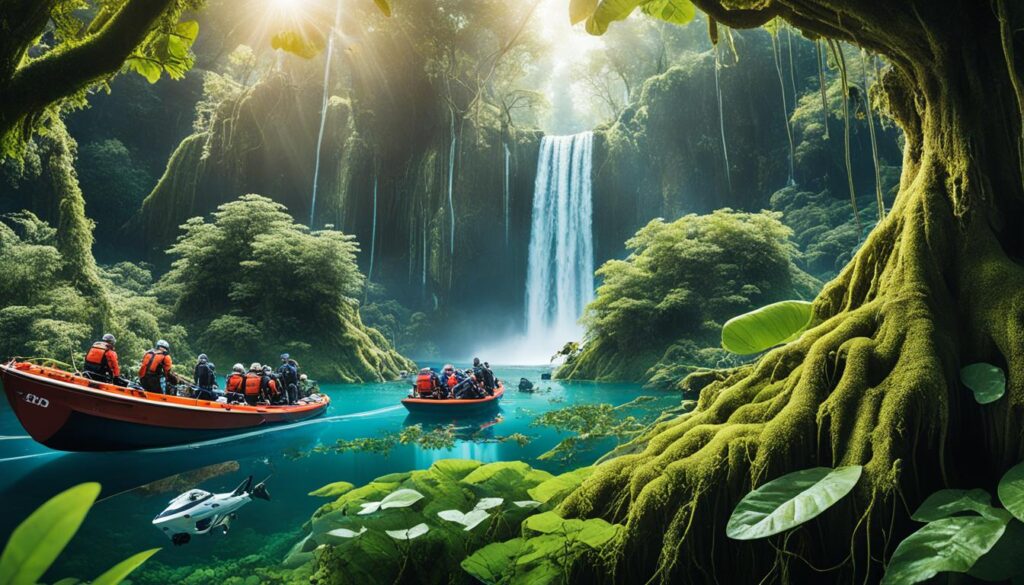
The Role of Citizen Science
Citizen science initiatives offer a promising avenue for freshwater invertebrate conservation. Empowering individuals, schools, and communities to participate in biodiversity monitoring not only increases public awareness but also generates valuable data on these organisms. Engaging citizens in hands-on conservation efforts fosters a sense of stewardship and a deeper understanding of the importance of freshwater invertebrates.
The Importance of Adaptation
Adapting conservation strategies to the ever-evolving challenges is paramount for the long-term survival of freshwater invertebrates. As new threats emerge, conservationists must remain flexible and responsive. By continuously reassessing and refining strategies, they can effectively address emerging issues and ensure the ongoing conservation of these vital organisms.
Addressing Knowledge Gaps
While significant progress has been made in understanding freshwater invertebrates, there is still much to learn. Research efforts must continue to fill knowledge gaps and enhance our understanding of their ecological roles and specific conservation needs. By investing in research and monitoring programs, we can refine conservation strategies and protect these vulnerable organisms more effectively.
The Role of Freshwater Invertebrates in Ecosystem Services
Freshwater invertebrates play a vital role in providing essential ecosystem services that directly impact human well-being. These small organisms contribute significantly to water quality, nutrient cycling, food webs, and serve as indicators of ecosystem health and functioning.
One of the crucial ecosystem services provided by freshwater invertebrates is their ability to filter out pollutants from the water. These organisms act as natural water purifiers, removing harmful substances and improving water quality. Through their feeding activities, they help to reduce nutrient pollution, such as excess phosphorus and nitrogen, which can lead to eutrophication.
Additionally, freshwater invertebrates contribute to nutrient cycling by decomposing organic matter, such as leaves, twigs, and dead organisms, in aquatic ecosystems. They break down these materials and release nutrients back into the water, making them available to other organisms. This process ensures the overall productivity of the ecosystem and helps maintain a healthy balance in nutrient levels.
Freshwater invertebrates also serve as a vital food source for other organisms, including fish, amphibians, and birds. They form the base of the food web, transferring energy from lower trophic levels to higher ones. The abundance and diversity of invertebrates in a water body directly influence the availability of food resources for higher-level predators.
Furthermore, freshwater invertebrates act as indicators of overall ecosystem health. Changes in their population size, diversity, and composition can reflect alterations in water quality, habitat conditions, and pollution levels. Monitoring the presence and abundance of these organisms can provide valuable insights into the ecological status of a water body and the effectiveness of conservation efforts.
“Freshwater invertebrates play a vital role in maintaining water quality, nutrient cycling, and food webs, making them integral to healthy aquatic ecosystems. Their presence and abundance serve as important indicators of ecosystem health and provide invaluable insights into the overall well-being of freshwater environments.”
By recognizing the importance of freshwater invertebrates in providing ecosystem services, we can guide and inform effective conservation strategies. Protecting and preserving these organisms and their habitats is crucial for maintaining water quality, sustaining biodiversity, and ensuring the long-term functioning of freshwater ecosystems.

Education and Awareness for Freshwater Invertebrate Conservation
Education and awareness initiatives play a crucial role in freshwater invertebrate conservation. By promoting the understanding of the importance of these organisms and their connection to ecosystem health, conservation organizations can foster a sense of environmental stewardship. Outreach programs, workshops, and educational materials can engage individuals of all ages and backgrounds, creating a collective effort towards freshwater invertebrate conservation.
Engaging the Community
One of the key strategies for promoting education and awareness is to engage the community in conservation efforts. By organizing workshops, field trips, and community events, individuals can learn about the fascinating world of freshwater invertebrates and the need to protect their habitats. These activities provide hands-on learning experiences and foster a sense of connection and empathy towards these often overlooked creatures.
Raising Awareness in Schools
An important target audience for freshwater invertebrate education is schools. By incorporating lessons and activities about freshwater ecosystems and the role of invertebrates, children can develop a lifelong appreciation for these organisms and a commitment to their conservation. Science classes can include experiments and observations of live invertebrates, while art and writing classes can explore creative ways to raise awareness about their importance.
Collaboration with Conservation Organizations
Conservation organizations play a critical role in driving education and awareness initiatives. These organizations can collaborate with schools, universities, and local communities to develop educational resources, including brochures, posters, and online materials. They can also organize training sessions for teachers, providing them with the tools and knowledge to incorporate freshwater invertebrate conservation into their curricula.
“Education is the most powerful weapon which you can use to change the world.” – Nelson Mandela
Digital Outreach and Online Resources
The digital age provides numerous opportunities for education and awareness. Conservation organizations can create engaging websites, interactive games, and virtual tours that allow individuals to explore the world of freshwater invertebrates from the comfort of their homes. Online resources, such as videos, podcasts, and webinars, can also reach a broader audience and spread knowledge about the importance of these organisms.
Collaborations with Research Institutions
Collaborating with research institutions can enhance education and awareness efforts. Scientists and researchers can share their expertise through outreach programs and public lectures, enlightening audiences about their discoveries and the value of freshwater invertebrates. By showcasing the latest research findings, these collaborations inspire curiosity and encourage individuals to get involved in conservation efforts.
The Power of Social Media
Social media platforms offer a powerful tool for reaching a wide audience. Conservation organizations can leverage platforms such as Facebook, Instagram, and Twitter to share educational content, conservation success stories, and updates on ongoing projects. Engaging and interactive posts can encourage individuals to share information with their networks, amplifying the reach and impact of freshwater invertebrate conservation outreach.
By combining these various education and awareness strategies, conservation organizations can inspire individuals to take action and contribute to the conservation of freshwater invertebrates and their habitats.
Conclusion
Freshwater invertebrates are crucial for the health and balance of aquatic ecosystems. They contribute to maintaining water quality, nutrient cycling, and overall ecosystem functioning. Monitoring the diversity and abundance of these fascinating creatures provides valuable insights into the condition of aquatic ecosystems and the effectiveness of conservation efforts.
To protect and conserve freshwater invertebrates, it is essential to address the threats they face. Implementing conservation strategies such as habitat restoration and pollution control can help create healthier environments for these organisms. Additionally, educating the public about the importance of freshwater invertebrates and their roles in ecosystem health fosters a sense of stewardship and contributes to conservation efforts.
By taking collective action and raising awareness, we can ensure the future preservation of freshwater invertebrates and the biodiversity they represent. Conservation of these organisms is not only essential for the well-being of aquatic ecosystems but also for our own well-being as they provide valuable ecosystem services. Let us work together to protect and conserve these incredible creatures and the vital ecosystems they call home.
FAQ
What are freshwater invertebrates?
What is the role of freshwater invertebrates in aquatic ecosystems?
What are the threats to freshwater invertebrates?
Why is monitoring freshwater invertebrates important?
What did the European study on freshwater invertebrates reveal?
How do freshwater invertebrates help in water quality assessment?
What are the conservation strategies for freshwater invertebrates?
How can citizen science contribute to freshwater invertebrate conservation?
What are the future challenges and opportunities in freshwater invertebrate conservation?
What is the role of freshwater invertebrates in ecosystem services?
How can education and awareness contribute to freshwater invertebrate conservation?
How can we protect and conserve freshwater invertebrates?
Paul’s love for animals knows no bounds. As a dedicated writer and animal lover, Paul brings a unique perspective to our team. His firsthand experiences with various animals enrich our content and provide valuable insights into their behavior and needs. Whether he’s sharing tips for pet care or shedding light on pressing conservation issues, Paul’s passion for animals shines through in everything he does.
Dogs
Top 5 Powerful Ares-Inspired Names for Your Brave Dog
Discover the top 5 powerful Ares-inspired names for your brave dog, starting with the letter 'A', to give your loyal companion a name that embodies strength and courage.
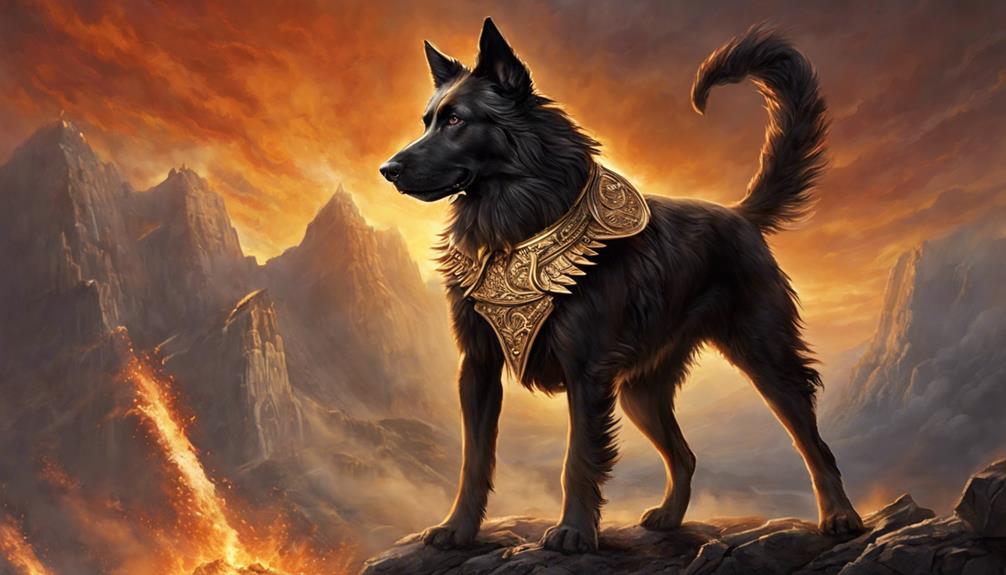
When naming your brave dog, consider powerful names like Mars, Athena, Achilles, Hera, and Zeus. Mars symbolizes warlike strength; Athena embodies wisdom and courage; Achilles reflects heroic valor; Hera displays regal authority; Zeus embodies divine might. These names evoke courage, wisdom, heroism, authority, and strength, perfect for a loyal and brave companion. Each name carries a unique and powerful essence inspired by legendary figures. Choosing one of these names for your dog can imbue them with a sense of valor and strength worthy of their brave spirit. More insights await on these powerful and fitting options for your courageous canine.
Key Takeaways
- Mars: Reflects bravery and strength for a powerful dog.
- Athena: Symbolizes courage and wisdom, ideal for a brave canine.
- Achilles: Signifies unmatched courage and resilience in a dog.
- Hera: Exudes authority and strength, perfect for a regal dog.
- Zeus: Represents supreme authority and leadership for a strong dog.
Mars: The God of War
As the Roman god of war, Mars reigns supreme in the domain of courage and power. Known for his fierce and fearless nature, Mars embodies the essence of bravery and strength in Roman mythology.
The mythical name Mars evokes images of a noble warrior, ready to face any challenge with unwavering courage and determination. Choosing this name for your dog can instill a sense of valor and leadership, reflecting the qualities associated with this legendary deity.
Mars symbolizes protection and military prowess, making it a fitting choice for a loyal and brave companion who stands by your side through thick and thin. With a name like Mars, your dog will exude authority and fearlessness, embodying the spirit of a true warrior in every adventure you undertake together.
Embrace the power and resilience of Mars as you celebrate the courageous nature of your canine companion.
Athena: Warrior Goddess

Let's explore the formidable persona of Athena, the revered Warrior Goddess in Greek mythology. Athena, the Greek goddess of wisdom, courage, and warfare, embodies strength and strategic prowess. Often depicted with a helmet and shield symbolizing protection and battle readiness, she's associated with the city of Athens, where her name inspired the city's name and where she was highly esteemed. Known for her intelligence, justice, and skill in combat, Athena is a powerful and independent deity.
Choosing the name Athena for your female dog can reflect valor, wisdom, and a fierce spirit. This name carries a sense of bravery and intelligence, ideal for a courageous and smart companion. If you seek a name that embodies strength and strategic thinking for your brave canine companion, Athena is a fitting choice. Embrace the essence of this warrior goddess by bestowing her name upon your loyal and fearless dog.
Achilles: Heroic Fighter
Delving into the valor and heroic nature of Achilles, a legendary Greek hero, exposes a tale of bravery and fighting prowess in the context of the Trojan War. Achilles is renowned for his unmatched courage on the battlefield, embodying strength and resilience in the face of adversity. The name Achilles, derived from the Greek word 'Achilleus,' meaning 'pain' or 'lipless,' symbolizes the indomitable spirit of a true warrior.
When considering naming your dog Achilles, you aren't just giving them a title but also a legacy of fearlessness and boldness. This moniker serves as a tribute to one of the most celebrated fighters in Greek mythology, reflecting your dog's heroic nature and unwavering determination. Just like Achilles, your furry family member will exude bravery and fortitude, ready to tackle any challenge that comes their way.
Hera: Queen of the Gods

Hera, the Queen of the Gods in Greek mythology, commands respect with her regal presence and association with marriage, family, and childbirth. When considering a name for your brave dog, drawing inspiration from Hera can instill a sense of power and grace. Here are some reasons why Hera deserves a name that reflects her majestic qualities:
- Regal Authority: Just like Hera's commanding presence among the gods, your dog can exude authority with a name inspired by the Queen of the Gods.
- Family Protector: Hera's dedication to family makes her a fitting namesake for a loyal and protective companion who values kinship.
- Nurturing Spirit: Associated with childbirth, Hera symbolizes nurture and care, qualities that can be reflected in your dog's name choice.
- Strength and Beauty: Much like the sacred animals of the cow and peacock, a name inspired by Hera can embody both strength and beauty, creating a well-rounded identity for your dog.
Zeus: King of Olympus
Drawing inspiration from the regal authority and commanding presence of Hera, we now shift our focus to Zeus, the mighty King of Olympus in Greek mythology.
Zeus is the powerful ruler of the Olympian gods, known for his thunderbolt and supreme authority over the heavens and earth. Depicted as a regal figure exuding strength and leadership, Zeus symbolizes divine power and courage.
Choosing Zeus as a name for your brave dog can evoke a sense of majesty and strength. When contemplating names for your canine companion, going back to Greek mythology and selecting a name like Zeus can imbue your pet with a sense of regality and power.
The name Zeus carries a weight of significance that can honor your dog's bravery and noble spirit. If you seek a name that resonates with authority and leadership, Zeus is unquestionably one of the top choices to ponder for your loyal companion.
Frequently Asked Questions
What Was Ares Dog Name?
Ares' loyal canine companion was named Enyalios. This fierce and devoted hound stood by Ares in battle, embodying bravery and strength. Naming your dog Enyalios can symbolize valor and steadfastness, reflecting Ares' qualities.
What Name Means Brave for Dog?
We believe the name 'Valor' embodies bravery for a dog. It reflects courage and strength, ideal for a fearless companion. Choosing a name like this can inspire admiration and respect for your loyal and courageous pup.
What Is a Powerful Dog Name?
We believe a powerful dog name embodies strength and valor, reflecting the dog's courageous spirit. It's a name that commands respect and instills confidence in both the pup and the owner, fostering a bond built on loyalty and bravery.
What Is a Legendary Name for a Dog?
We believe a legendary name for a dog embodies strength, history, and honor. It signifies qualities we admire in our loyal companions. Choosing such a name can deepen our bond and elevate our furry friend's presence in our lives.
Conclusion
To sum up, selecting a powerful and motivating name for your courageous dog can bring a touch of strength and personality to your furry companion. Whether you opt for Mars, Athena, Achilles, Hera, or Zeus, each name carries a deep history and conveys a feeling of bravery and resilience.
By choosing one of these Ares-inspired names, you aren't only paying tribute to ancient mythology but also giving your dog a name that mirrors their brave and noble nature. Choose wisely and observe your dog embody the essence of their powerful namesake.
As our Editor-in-Chief, James plays a pivotal role in ensuring the quality and integrity of our content. With a keen eye for detail and a passion for storytelling, James oversees the editorial process here at A Place for Animals. With years of experience in content editing, James ensures that every piece of content meets our high standards of accuracy and clarity. Under James’ guidance, you can rest assured that the content you read is informative and impeccably crafted.
Dogs
Dogs Have Rhubarb: What You Need to Know

Dogs can get sick from rhubarb, causing serious health problems. It's important for us to understand the risks of dogs eating rhubarb. Symptoms of rhubarb poisoning include mouth and throat pain, as well as breathing trouble. Make sure rhubarb plants are out of reach and train dogs to avoid harmful plants. If you suspect ingestion, go to the vet right away. Treatment involves inducing vomiting and using activated charcoal. Immediate help is essential to prevent kidney damage. Being informed about rhubarb poisoning in dogs is critical. More valuable information is waiting to be discovered.
Key Takeaways
- Rhubarb is toxic to dogs, causing mouth pain, inflammation, and breathing difficulties.
- Prevent rhubarb poisoning by keeping plants out of reach and training dogs to avoid harmful plants.
- Symptoms of rhhubarb poisoning include drooling, weakness, loss of appetite, and lethargy.
- Immediate vet care is crucial if ingestion is suspected to prevent kidney damage.
- Healthy dog treats are important for overall health, immunity, coat quality, and dental care.
Rhubarb Poisoning Symptoms in Dogs
When dogs ingest rhubarb, they may exhibit symptoms of poisoning that include mouth and throat pain, inflammation, and difficulty breathing. Rhubarb contains oxalate crystals, which are toxic to dogs and can lead to serious health issues. These crystals cause irritation and damage to the mouth and throat, resulting in pain and inflammation. Additionally, if the crystals are ingested in large quantities, they can lead to difficulty breathing, making it vital to seek immediate veterinary care if you suspect your dog has consumed rhubarb.
Oxalate crystals in rhubarb can also contribute to renal failure in dogs, further highlighting the importance of recognizing and addressing symptoms of rhubarb poisoning promptly. If your dog shows signs of mouth and throat pain, inflammation, or difficulty breathing after ingesting rhubarb, it's essential to seek professional help. Remember, early detection and intervention are key in ensuring the well-being of your furry friend when faced with potential toxic exposure to rhubarb.
Preventive Measures for Rhubarb Ingestion

When it comes to safeguarding our furry friends from rhubarb ingestion, there are a few key steps to remember.
First, make sure rhubarb plants are placed out of your dog's reach to prevent accidental consumption.
Second, train your dog to avoid harmful plants like rhubarb using positive reinforcement techniques.
Rhubarb Toxicity Symptoms
To prevent rhubarb toxicity in dogs, it's essential to be aware of the symptoms and take immediate preventive measures upon ingestion. Rhubarb is toxic to pets due to the presence of calcium oxalate, which can lead to various symptoms. Here are some precautionary steps to keep in mind:
- Monitor for Symptoms: Keep an eye out for signs such as drooling, weakness, tremors, and changes in thirst and urination.
- Induce Vomiting: If ingestion occurs, induce vomiting to eliminate the toxins from the system.
- Administer Activated Charcoal: Give activated charcoal to help absorb any remaining toxins in the stomach.
- Consult a Vet: Seek immediate veterinary assistance for further treatment options and care.
Being proactive and informed can help safeguard your furry friend's health.
Treatment Options Available
Implementing preventive measures is essential in ensuring dogs are kept safe from the dangers of rhubarb ingestion. Rhubarb is a toxic plant that can lead to kidney failure in dogs if ingested. To prevent this, keep rhubarb plants out of reach of your furry friends.
Training dogs to steer clear of harmful plants like rhubarb can also help avoid ingestion. Be cautious with food scraps containing rhhubarb, as accidental consumption can occur.
Supervise your dogs in areas where rhubarb grows to prevent access. These simple steps can greatly reduce the risk of rhubarb ingestion and the associated health issues. Remember, quick action is vital in protecting your pet's well-being.
Consult Veterinarian Immediately
Taking prompt action by consulting a veterinarian is essential when a dog has potentially ingested rhubarb to prevent serious health complications. If your dog has consumed rhubarb leaves, immediate veterinary assistance is vital to avoid kidney damage.
Here are four preventive measures to safeguard your furry friend:
- Consult a Veterinarian: Seek professional guidance promptly.
- Avoid Delay: Time is of the essence in such cases.
- Provide Relevant Information: Share details about the quantity and time of ingestion.
- Consider Calcium: In some cases, calcium can help reduce the absorption of toxins.
Treatment Options for Rhhubarb Poisoning

When a dog shows symptoms of rhubarb poisoning, such as drooling or vomiting, immediate veterinary care is vital.
In severe cases, complications like kidney failure can arise, emphasizing the importance of prompt treatment.
Understanding the potential complications and acting swiftly can greatly improve the chances of a positive outcome for your furry friend.
Symptoms of Poisoning
In cases of rhubarb poisoning in dogs, recognizing the symptoms promptly is essential for initiating appropriate treatment. Symptoms may include drooling, loss of appetite, weakness, tremors, and changes in thirst and urination.
To address rhubarb poisoning in dogs effectively, consider the following treatment options:
- Inducing vomiting: This can help remove the ingested rhubarb from the system.
- Administering activated charcoal: This aids in absorbing toxins present in the digestive tract.
- Providing IV fluids for toxin elimination: Fluid therapy supports the body in flushing out toxins.
- Monitoring calcium levels: Rhubarb poisoning can affect calcium levels, requiring close monitoring for proper treatment.
Being aware of these symptoms and treatment options is critical in ensuring the well-being of dogs that have ingested rhubarb.
Immediate Veterinary Care
For immediate veterinary care in cases of rhubarb poisoning, our primary focus is on inducing vomiting or administering activated charcoal to counteract toxin ingestion. Rhubarb contains oxalic acid, which can be harmful to dogs when consumed in large amounts. Inducing vomiting helps expel any remaining rhubarb from the stomach, reducing further absorption of toxins.
Activated charcoal works by binding to the toxins in the gastrointestinal tract, preventing them from being absorbed into the bloodstream. These treatment options aim to minimize the effects of rhubarb poisoning and support the dog's recovery.
If your dog ingests rhubarb, seeking immediate veterinary care is essential. Consider having pet insurance to help cover the costs of unexpected emergencies like rhubarb poisoning.
Potential Complications
To address potential complications of rhubarb poisoning in dogs, treatment options such as inducing vomiting, administering activated charcoal, and providing IV fluids are vital. When dealing with soluble calcium oxalate ingestion, managing low blood calcium levels is essential. Here are four key steps in treating rhubarb poisoning complications:
- Inducing Vomiting: This helps remove any remaining rhubarb from the stomach.
- Administering Activated Charcoal: It binds to toxins, preventing further absorption.
- IV Fluids: These help flush out toxins and maintain hydration.
- Monitoring Calcium Levels: Essential for preventing complications associated with low blood calcium levels.
Safe Treat Alternatives for Dogs

What're some safe and healthy alternatives for treating dogs?
When it comes to rewarding your furry friend, there are various options that aren't only secure but also enjoyable for them. Fruits like apples, bananas, and blueberries can make delicious treats for dogs. These fruits aren't only tasty but also packed with essential nutrients that can benefit your dog's health. Additionally, vegetables such as carrots and green beans are excellent choices for dogs, providing them with essential vitamins and fiber.
If you prefer a more convenient option, commercial dog treats are readily available and secure for dogs. These treats come in a variety of flavors and sizes, catering to different preferences and dietary needs. For those who enjoy getting creative in the kitchen, making homemade treats using dog-friendly recipes can be a fun and rewarding experience. By consulting with a vet, you can make sure that the treats you choose are suitable for your dog's specific needs and preferences. Remember, treating your dog should be a pleasurable experience for both you and your furry companion.
Recognizing Signs of Poisoning in Dogs

Exploring the signs of poisoning in dogs reveals important information for pet owners to guarantee their furry companions' well-being. When it comes to recognizing signs of poisoning in dogs, it's essential to be alert and observant to protect your pet.
Here are four key signs to watch out for:
- Drooling: Excessive drooling can be an indication that your dog has ingested something toxic, such as rhubarb.
- Loss of Appetite: If your dog suddenly loses interest in food or treats, it could suggest poisoning and shouldn't be ignored.
- Weakness and Lethargy: A noticeable decrease in energy levels or overall weakness may indicate that your dog is experiencing poisoning symptoms.
- Sudden Drop in Calcium Levels: Keep an eye out for symptoms like tremors and changes in thirst and urination, as these can suggest a sudden drop in calcium levels, which could be caused by plant poisoning.
Being aware of these signs can help you act promptly to make sure your dog receives the necessary care in case of poisoning.
Immediate Veterinary Help for Dogs

Seeking immediate veterinary assistance is essential when a dog has ingested rhubarb leaves. Rhubarb toxicity can lead to symptoms like drooling, vomiting, diarrhea, weakness, and tremors in dogs.
The soluble calcium oxalate crystals present in rhubarb leaves are particularly critical as they can cause kidney failure and lower blood calcium levels in our furry friends. When faced with such a situation, it's important to get professional veterinary help promptly.
The vet may induce vomiting to remove the ingested rhubarb, administer activated charcoal to help absorb any remaining toxins, and closely monitor the dog's calcium levels to prevent any complications. Time is of the essence in such cases, so don't hesitate to contact your vet or an emergency animal clinic if you suspect your dog has ingested rhubarb leaves.
Dangers of Rhubarb Ingestion

After addressing immediate veterinary concerns for dogs who've ingested rhubarb, understanding the dangers of rhubarb ingestion becomes essential.
- Soluble Calcium Oxalate: Rhubarb toxicity in dogs is primarily caused by soluble calcium oxalate crystals present in the rhubarb plant. These crystals can lead to severe health issues if ingested.
- Renal Failure Risk: Ingesting any part of the rhubarb plant can potentially result in renal failure in dogs. This organ failure can be life-threatening and requires immediate medical attention.
- Symptoms of Poisoning: Dogs experiencing rhubarb poisoning may exhibit symptoms such as mouth and throat pain, inflammation, and difficulty breathing. Recognizing these signs early is critical for prompt treatment.
- Veterinary Intervention: Veterinary tests like blood count and urinalysis can help confirm the presence of soluble calcium oxalate and assess the dog's renal function. Timely intervention and appropriate treatment can improve the chances of a successful recovery.
Understanding these dangers empowers us to take proactive steps in preventing rhubarb ingestion and safeguarding our furry friends' well-being.
Importance of Healthy Dog Treats

Choosing nutritious dog treats is crucial for your pet's health and well-being. Dogs need a balanced diet that includes high-quality treats to maintain a healthy weight and prevent obesity. Treats made with natural ingredients can boost your dog's immune system and promote a shiny coat. Avoid treats with artificial additives or excessive sugars to prevent dental issues. Offering a variety of healthy treats keeps your dog engaged and satisfied during training sessions while providing essential nutrients for a happy, active life. Just as we choose the best for ourselves, selecting wholesome treats shows love and care for our furry friends.
Frequently Asked Questions
What Do I Do if My Dog Eats Rhubarb?
If your dog eats rhubarb, immediate rinsing with cool water can help. Providing cool food or drink can ease pain and irritation. Mild cases may only need mouth rinsing and pain relief. Larger ingestions may require vet evaluation, IV fluids, and toxin removal. Antihistamines and gastroprotective meds may be given.
Always seek veterinary advice if concerned about rhubarb consumption, as it can be harmful to pets.
What Are the Symptoms of Rhubarb Poisoning?
Rhubarb poisoning in dogs presents with symptoms like mouth and throat pain, inflammation, and breathing difficulties. This can lead to renal failure if the body absorbs the toxins. Immediate signs such as oxalate crystals aid in detection.
Veterinary tests, including blood counts and urinalysis, confirm the toxin's presence and assess kidney function. Vomiting of plant material often confirms rhubarb poisoning. If your dog shows these symptoms, seek immediate veterinary care.
Are Dogs Attracted to Rhubarb?
Yes, dogs can be attracted to rhubarb for various reasons. The unique scent and bright colors of rhubarb may catch a dog's attention, leading them to investigate the plant out of curiosity.
Some dogs may be drawn to the texture of rhubarb leaves, mistaking them for a chew toy or snack. It's important to prevent dogs from consuming rhubarb as it can be harmful and toxic to their health.
Is Rhubarb Toxic to Dogs or Cats?
Rhubarb is harmful to dogs and cats due to soluble calcium oxalate crystals. Ingesting rhubarb can cause digestive problems, kidney damage, and neurological symptoms in pets. The leaves are particularly hazardous and should be kept away from animals.
Symptoms of rhubarb toxicity include excessive saliva, throwing up, weakness, and shaking. Immediate veterinary care is vital if a pet consumes rhubarb to prevent severe health issues.
Conclusion
To sum up, remember that dogs and rhubarb don't mix well. Keep your furry friends safe by preventing them from ingesting this potentially harmful plant.
If you suspect your dog has eaten rhubarb, seek immediate veterinary assistance to guarantee their well-being.
Stick to safe treat alternatives and always be vigilant when it comes to what your dog eats. Your pet's health is worth the extra caution.
Stay informed and keep those tails wagging!
Dana is our Lead Content Writer, bringing a wealth of knowledge and expertise to our team. With a background deeply rooted in animal studies and a profound love for all creatures, Dana is dedicated to crafting engaging and informative content that resonates with our audience. With Dana at the helm, you can trust that our content is accurate and engaging, catering to the diverse interests of animal enthusiasts everywhere.
Cats
7 Adorable Japanese Names for Cats
Discover 7 enchanting Japanese cat names starting with 'S', each embodying elegance, magic, and whimsy – perfect for your feline companion!

Get ready to fall in love with 7 adorable Japanese names for cats! From Cherry Blossom-Inspired names evoking elegance to Celestial names infusing cosmic magic, each name captures a unique charm. Consider Elegant Lotus names symbolizing purity or Whimsical Oceanic names reflecting the sea's beauty. Serene Bamboo names showcase resilience, while Moonlight names glow with magic. Don't forget Playful Origami names adding whimsy! These names blend tradition, beauty, and grace, perfect for your feline friend. Each name holds a special meaning and significance, embodying the essence of Japanese culture and aesthetics.
Key Takeaways
- Cherry Blossom-Inspired Names: Reflect beauty and elegance, perfect for a graceful feline companion.
- Celestial Names: Infuse cosmic magic, adding grace and mystery to your cat's identity.
- Lotus Names: Symbolize purity and sophistication, connecting to Japanese values and traditions.
- Oceanic Names: Capture the sea's beauty and playfulness, ideal for a dynamic feline personality.
- Bamboo Names: Reflect resilience and tranquility, showcasing the beauty and significance of bamboo.
Cherry Blossom-Inspired Cat Names
Cherry blossom-inspired cat names hold a special place in Japanese culture, reflecting the beauty and significance of sakura. In Japan, these names carry a sense of elegance and tradition, drawing inspiration from the fleeting beauty of cherry blossoms. Names like Sakura, Hana, and Hanami evoke feelings of grace and renewal, capturing the essence of springtime in every syllable. The cultural importance of cherry blossoms is further emphasized during cherry blossom festivals in Japan, where the blooming of sakura trees is celebrated with great joy and reverence.
Choosing a cherry blossom-inspired name for your feline companion not only adds a touch of Japanese charm to their identity but also connects them to a rich cultural heritage. It's a way to honor the beauty of nature and express admiration for the delicate yet profound symbolism of sakura. So, if you're looking for a name that exudes grace and sophistication, a cherry blossom-inspired name might be the perfect choice for your beloved cat.
Celestial Cat Names

When considering celestial cat names, we're drawn to the enchanting allure of the cosmos. These starry feline titles, such as Luna or Orion, can infuse your cat's identity with a touch of heavenly magic.
Cosmic cat monikers like Nova or Nebula evoke a sense of wonder and beauty that mirrors the mysteries of the universe.
Starry Feline Titles
Inspired by the enchanting elements of the night sky, celestial cat names bring a touch of cosmic wonder to your feline friend's identity. These names aren't just labels but reflections of the grace, beauty, and unique personalities of our beloved cats.
Here are four reasons why celestial cat names are a purrfect choice for your furry companion:
- Mystery and Wonder: Celestial names like Luna or Nova evoke a sense of mystery and wonder, adding an intriguing charm to your cat's persona.
- Cosmic Charm: Naming your cat after stars, moons, or galaxies infuses a magical quality into their everyday presence.
- Graceful Reflection: Celestial cat names reflect the elegance and beauty that our feline friends possess.
- Unique Identity: These names provide a distinct and memorable identity for your cat, setting them apart with cosmic flair.
Heavenly Kitty Names
What celestial qualities make heavenly kitty names stand out as unique choices for our feline companions?
Celestial cat names draw inspiration from the heavens and celestial bodies, embodying beauty, mystery, and wonder. Names like Luna, Stella, Celeste, Nova, and Comet not only sound mesmerizing but also add a touch of magic to your cat's identity.
By choosing a celestial name, you can reflect your cat's individual personality and charm, giving them a name that truly sparkles like a star in the night sky. These names create a sense of connection to the vast universe above us, making your feline friend feel like a celestial being right in your home.
Embrace the celestial allure with these enchanting Japanese names for your beloved kitty.
Cosmic Cat Monikers
Drawing inspiration from the cosmic wonders above, celestial cat names bring a touch of magic and fascination to your feline companion's identity. When choosing a celestial name for your cat, consider the following:
- Celestial Bodies: Stars, moons, and galaxies provide rich inspiration for unique cat names like Luna and Orion.
- Sense of Mystery: These names evoke a sense of mystery and wonder, adding an enigmatic charm to your cat's persona.
- Cosmic Beauty: Names such as Nova, Nebula, and Comet reflect the cosmic beauty and uniqueness of your feline friend.
- Reflecting Personality: Celestial cat names can mirror your cat's individuality and otherworldly charm, enhancing their overall appeal.
Elegant Lotus Names for Cats

Lotus-inspired cat names can bring a touch of elegance and cultural depth to your feline companion.
Names like Hasu, Ren, and Renge draw inspiration from the graceful lotus flower, symbolizing purity and beauty in Japanese tradition.
Embracing a lotus-themed name for your cat can infuse their identity with a sense of grace and serenity.
Lotus-inspired Cat Monikers
Embracing the essence of elegance and cultural significance, choosing a lotus-inspired name for your feline companion can infuse their identity with grace and depth. In Japanese culture, lotus flowers symbolize purity, enlightenment, and rebirth, making them ideal inspirations for cat names. Here are four reasons why lotus-inspired names like Ren (蓮) or Hasu (蓮) can be a perfect fit for your cat:
- Symbol of Beauty: Lotus flowers are known for their beauty, mirroring the grace and elegance of your feline friend.
- Spiritual Significance: Naming your cat after a lotus can represent spiritual growth and inner peace.
- Cultural Depth: Adding a lotus-inspired name can connect your cat to Japanese traditions and values.
- Elegance and Sophistication: These names evoke a sense of sophistication and refinement, reflecting your cat's unique qualities.
Petite Floral Feline Names
Our selection of petite floral feline names captures the essence of elegance and grace, embodying the purity and beauty symbolized by the lotus flower. Japanese cat names with meanings inspired by lotus flowers offer a unique touch of sophistication and refinement to your feline companion's identity.
These names, reflecting the delicate nature of cats, evoke tranquility and serenity, enhancing the bond between you and your pet. By choosing a lotus-inspired name, you connect your cat to the peaceful essence of nature, adding a sense of grace to their character.
Each name carries a deeper significance, symbolizing beauty and purity, aligning perfectly with the elegance of your Japanese cat. Embrace the beauty of the lotus with a name that reflects the serene and exquisite nature of your feline friend.
Whimsical Oceanic Cat Names

Indulge in the charm of whimsical oceanic cat names that capture the essence of the sea's beauty and mystery. When selecting a name for your feline friend, consider the tranquility and vastness of the ocean as inspiration.
Here are four oceanic-inspired Japanese cat names to add a touch of enchantment to your pet:
- Kai – Meaning 'ocean' in Japanese, this name embodies the deep, boundless nature of the sea, perfect for a cat who exudes a sense of freedom and fluidity.
- Mizu – Translating to 'water,' Mizu symbolizes the ever-flowing and adaptable qualities of the ocean, ideal for a cat with a playful and dynamic personality.
- Sora – Representing 'sky,' Sora reflects the interconnectedness of the heavens and the sea, making it a fitting choice for a cat who loves to explore and dream.
- Nami – Signifying 'wave,' Nami captures the rhythmic and soothing movements of the ocean, suitable for a cat with a calming presence and graceful demeanor.
Serene Bamboo Names for Cats

Bamboo-inspired names for cats offer a serene and meaningful way to reflect the resilience and tranquility present in Japanese culture. In Japan, bamboo symbolizes flexibility and strength, making it a perfect source for unique cat names.
Takeo, meaning 'bamboo man,' Takeda, signifying 'bamboo rice field,' or Chikako, representing 'child of a thousand bamboos,' all showcase the beauty and significance of bamboo in Japanese cat names. These names bring a touch of nature, simplicity, and elegance to your feline companion, aligning perfectly with their graceful demeanor.
Enchanting Moonlight Cat Names

Shroud your feline friend in a mantle of enchantment with these mesmerizing Moonlight Cat Names. Moon-inspired Japanese names carry a sense of mystery and elegance, perfect for capturing the beauty and tranquility of the night sky. Embrace the celestial charm and grace with these enchanting names:
- Tsuki – Meaning moon, this name encapsulates the serene glow and magic of the moonlit nights, bringing a touch of celestial beauty to your cat's persona.
- Luna – A popular moon-related name, symbolizing the celestial glow and grace that radiates from the moon, adding an air of mystique to your cat's identity.
- Yoru – Translating to night, this name reflects the enchanting and magical aura of the moonlight, evoking a sense of peace and tranquility.
- Hikari – Representing light, this name embodies the gentle radiance of the moon's glow, illuminating your cat's presence with a celestial charm.
Choose a moonlight-inspired name to infuse your beloved feline companion with a touch of celestial allure.
Playful Origami Cat Names

Let's explore the charm and creativity of Playful Origami Cat Names, inspired by the intricate art of Japanese paper folding. Naming your Japanese cat after an origami design can be a delightful way to capture their grace and elegance. These names not only reflect qualities like creativity but also add a touch of whimsy and playfulness to your feline friend's persona.
Choosing an origami-inspired name for your cat is a unique and creative decision that showcases your admiration for Japanese culture. Names like 'Kiku' (chrysanthemum), 'Sakura' (cherry blossom), and 'Tsuru' (crane) are popular choices that embody the beauty and intricacy of both origami and your beloved pet.
Embrace the art of origami by giving your cat a name that reflects the beauty and creativity of this traditional Japanese craft. Your playful origami cat won't only have a unique identity but also a name that symbolizes the elegance and charm they bring into your life.
Frequently Asked Questions
What Are Cute Japanese Pet Names?
We love sharing cute Japanese pet names like 'Mei' (sprout) and 'Kirei' (pretty). They're endearing choices that capture the charm of our furry friends. Sweet names like 'Chisai Tori' (little bird) add a touch of cuteness to our pets.
What Is the Cutest Cat Name?
When deciding on the cutest cat name, we explore endearing qualities that resonate with our hearts. It's a personal journey of discovery, seeking a name that encapsulates the essence of charm and love.
What Do Japanese Call Their Cats?
We call our feline friends in Japan 'neko,' a term of endearment. Japanese pet owners often use sweet names like 'nyanko' or 'nyanko-chan' for their cats. It reflects our affection for these adorable creatures.
What Is the Japanese Name for Lucky Cats?
We call lucky cats 'Maneki-Neko.' This beckoning feline brings good luck and fortune. The raised paw symbolizes beckoning fortune. It's a popular charm in Japan, believed to attract positive energy and keep evil spirits at bay.
Conclusion
To sum up, selecting a Japanese name for your cat can bring a hint of sophistication and allure to their identity. Just like a fragile cherry blossom tree, these names can blossom with beauty and elegance.
Whether you favor celestial, oceanic, or bamboo-inspired names, there are numerous choices to match your feline friend's personality.
So, why not give your furry companion a name as distinctive and delightful as they are?
Paul’s love for animals knows no bounds. As a dedicated writer and animal lover, Paul brings a unique perspective to our team. His firsthand experiences with various animals enrich our content and provide valuable insights into their behavior and needs. Whether he’s sharing tips for pet care or shedding light on pressing conservation issues, Paul’s passion for animals shines through in everything he does.
-

 Vetted2 months ago
Vetted2 months ago15 Best Cat Foods for Managing Hyperthyroidism – Vet Approved and Feline Friendly
-

 Animal Facts2 months ago
Animal Facts2 months agoSpring Animals: A Guide to Seasonal Wildlife
-

 Cats7 months ago
Cats7 months agoTop 5 Cat Breeders in Arkansas: A Guide
-

 Vetted2 months ago
Vetted2 months ago15 Best Dog Foods for Kidney Disease – Expert Recommendations for Your Pet's Health
-

 Vetted2 months ago
Vetted2 months ago15 Best Fresh Dog Food Delivery Services for Your Pup's Health and Happiness
-

 Rabbits2 months ago
Rabbits2 months agoExploring Rabbit Holes: What Do They Look Like?
-

 Pets2 months ago
Pets2 months agoLatest Pet Statistics in US – Trends & Insights in 2024
-

 Fish2 months ago
Fish2 months agoKeeping Your Sucker Fish Thriving at Home























